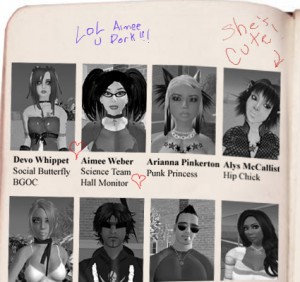 At the recent Ypulse Nat’l Mashup, I chatted with teen virtual goods wünderkind Asuka Martin also interviewed here by Benett Carter about Teen Second Life.
At the recent Ypulse Nat’l Mashup, I chatted with teen virtual goods wünderkind Asuka Martin also interviewed here by Benett Carter about Teen Second Life.
I’m fascinated by her composure in handling the mining of her intellectual property/content creation, (someone swiping her stuff) as well as the impact on her authentic brand of custom-created virtual textures and ‘skins,’ for she has an uplifting, inspiring, digital story to share.
Mind you, she was not faced with an ‘oopsie, my bad’ similar content creation but a deliberate knock-off (think content theft or overseas media pirating in copybot form)
Yep, I realize ‘imitation may be the highest form of flattery’ but as this primer on copyrighted content protection in Second Life maintains, the TOS (terms of service) negates infringement…Yet who’s to ‘enforce’ it and ‘how?’ Sheer quantity alone is daunting…But here’s her digital success story….
Get this: Her teen store clientele and close-knit community on the Teen Second Life grid was SO protective of her work, that when copybot issues infiltrated the island to snatch her TSL creations, her community of customers rallied to squash their pilfered efforts in vigilante style…Kinda like a bunch of small town sheriffs running the reckless rowdies out of town!
I’d say that sounds quite promising on the teen behavioral ethics front to me, in terms of building community and a neighborhood watch of kids looking out for each other so to speak!
Asuka Martin’s now on the Second Life ‘main grid’, since she turned 18 (here’s a YouTube teen tribute to Asuka Martin’s entrepreneurial coming of age transition from the teen grid to the main grid; an interesting emotional snapshot into the friendships kids share in immersive virtual worlds using machinima itself to tell the story)—
Mind you, she said things are very different on the SL main grid, and it’s almost like ‘starting all over’ again with her business. (the video tribute ends with the call to action, “Support Intergrid Commerce” )
Still, she’s very grounded and speaks of her success as an adjunct world, not a livelihood, and ultimately as a ‘game.’
Maybe this is how she buffers some of the ‘unfair/foul’ outcries of SL players annoyed with SL’s inability to police IP copycats after they’ve poured their creative souls into designing exclusive offerings…it all comes down to $$ loss, and I don’t mean the virtual kind.
Only 18, entrepreneur Asuka Martin has a very mature, Yoda-like way about her, seeing past the short-term frustration of ‘griefers’ and gadabouts, to view a more visionary power of community and the building of citizenship…
She clearly wants to create such a strong presence ‘in-world’ that people will ‘take care’ of each other in these online environs, much like the formation of offline community relationships…
This reinforces the whole community context and with it, the ethical responsibility and accountability for those designing such media environs in the first place…
I guess I still don’t quite ‘get it’ in terms of why anyone would recklessly risk ruination of reputation by pilfering code, unless they weren’t part of the ‘world’ to begin with (or weren’t planning on staying)…
You’d get bounced and reviled once ‘caught,’ either by Linden Lab folks or by peers…even if you made $ in short term gain, right? (I’m fuzzy on this, since SL is supposedly an ‘Open Sim’ platform, so it gets muddy. Help?
Then again, maybe the whole ‘avatars behaving badly’ focus is indicative of media’s propensity to focus on negative outcomes over positive ones in the digital game space?
Not saying this behavior doesn’t exist, but is it ‘normative?’
After all, sensationalized drama sells media; especially focusing on purposeful mayhem of griefers.
Here’s a great definition of a griefer btw, from Terra Nova and Prensky’s book (at left) with its helpful parent-teacher toolkit for conversation starters and resource articles worth a peek for digital naysayers universally…
Analysis of the conduct and motives of perpetual cheaters and ‘griefers’ is a huge blog post in itself for another time (esp. when pranksters dismiss abhorrent nastiness for ‘epic lulz’… (‘lulz’ is an aberration of ‘lol,’ laugh out loud, over-used in texting constantly; maybe someone got bored and added plurality, I dunno)
I’m more interested in seeing how we can best curtail opportunities for exploitation at the onset (peer to peer, engineering flaws, kids outsmarting the safety systems, etc.) and create engaging communities that aren’t total ‘lockbox’ snores or serving up constant coinage and consumption cues.
 Since I’ve heard so much about game cheats and ‘virtual nasties’ lately, I thought I’d harken back to one of the more common real world irks and quirks of time-honored tradition…people “wearing the same dress to prom” (so to speak).
Since I’ve heard so much about game cheats and ‘virtual nasties’ lately, I thought I’d harken back to one of the more common real world irks and quirks of time-honored tradition…people “wearing the same dress to prom” (so to speak).
I decided to pop into various virtual worlds to see how forthcoming ‘info-sharing’ and ‘cheats’ would be, querying “where’d you get your outfit’ (or ‘where did you get xyz virtual powers’) just to see what gives…
As a former journalist, my first rule of thumb has always been ‘see for yourself, don’t swallow the spin.’
Oooh, the drama…Would there be (shudder!) avatar jealousy?
Possessive ‘I’ve got mine’ divisiveness? Arrogant dismissal?
Paranoia of ‘cheats’ and copybot code pilfering?
Backstabbing raciness and vapid values like the media depictions in shows like ‘Gossip Girl’?
Nada. Mostly just kids having fun with fashion…(albeit a few rather skimpy ones)
In fact, I purposely coveted some of the most unusual creations of lovely formal gowns at a few different dance spots and jazz clubs on the main grid in Second Life to see what the reaction would be, chatting politely first, and eventually asking where one could get a similar dress…
In SL, one woman even directed me to an ‘in-world’ purveyor of this haute couture…(ahem, can’t say a teen would get that treatment in real life!)
Veeeeeerrrrry Interesting.
As an aside, don’t ask me why the SL adult/main grid has a whole ‘virtual prom/high school drama’ sim going on…(see ‘avatar yearbook’ at left) go figure! Thought maybe on the TSL grid, but hey
Ironically, it’s called KHS: Kindly High School—So maybe it’s the antithesis re-creation for folks who’d like a ‘do-over’ as they say on the K-5 playgrounds of life?
Digressing; I’m not saying my anecdotal “dress query” proved all that much, I’m just noting that NO ONE scammed me, wigged out, cursed me, or accused me of wanting to steal their look or any other anti-social ‘avatar behaviors,’ so it was much more ‘genteel’ behavior than this CBS video on “avatars behaving badly” depicted.
This bodes well for a sense of strong community/helpfulness vs. protective exclusivity (tho in fairness, these were the customers not the creators of the unique virtual goods, who would stand to lose $ in a ‘cheat/copybot/knock-off’ transaction, so it’s not a ‘high risk’ sample)
Still, it was heartening to observe firsthand as a ‘stranger in a strange land,’ delve into media bias a tad, and brainstorm the larger ethics/e-learning sociological questions…
How can we best instill the notion to design kids’ digital spaces with ‘ethical’ engineering integrities built-in (consequences, etc.) and community camraderie from the get-go?
Is it possible to use forethought and wisdom, anticipating best practices so kids can easily differentiate between fun, fantasy, feelings and fortitude?
![]() Seems the inherent challenge for developers within the younger kids’ virtual worlds is to create close-knit fun communities with their own codes of conduct, avoiding lawless profiteering from marketers run amok. (see “Virtual to Real World Play Patterns” synopsis distilled on Sara Grimes’ Gamine Expedition blog)
Seems the inherent challenge for developers within the younger kids’ virtual worlds is to create close-knit fun communities with their own codes of conduct, avoiding lawless profiteering from marketers run amok. (see “Virtual to Real World Play Patterns” synopsis distilled on Sara Grimes’ Gamine Expedition blog)
Can corporate commerce even coexist without infringing on the dialogue, altering conversations, and wrecking kids’ experiences altogether? If so how, if not why not?
AND…ALSO…to advocate for responsible moderation and game design consequences that help deter hurtful conduct with preventive measures (e.g. kids feeling duped, jaded, cynical, forlorn, used, scammed, looted, bullied etc. as this L.A. Times article suggests)
Online community guru Izzy Neis is grappling with this in her own stealth mode moderation teams at Six Degrees Games right now, as you can see in her blog post here where she reiterates the huge commitment to seeking out the utmost in qualified staff on the backend of designing ANY new space or virtual world for kids…
Personally, I’m dying to know what her project is, because I respect her integrity and KNOW she’s testing the bejeebers out of whatever she’s up to…examining ‘if this then this’ modalities of exploratory open-ended play, and safety with moderation, but NOT thwarting the whole purpose of being there by ‘bubble-wrapping’ kids.
She reminds us all about the very meaning of ‘beta’ in testing, refining, balancing, and finessing real world play patterns as she says:…
“…Aesthetics, staffing, tools, strategies, market plans – you name it – nothing is ever perfect. It’s a living breathing environment, and that “living breathing” needs constant support and attention. Things will happen, things will fail, things will become WAY more popular than you expected, and you’ll be hard pressed to nail any overtly intended subculture play patterns. But that’s the brilliance of this market, isn’t it? It’s the challenge, the excitement of bringing something so vibrant to a child’s fingertips.”
 I’m just VERY thankful there are pros like Izzy out there who are conscientious about what KIND of excitement is being brought to those fingertips and how to use the power of that media in a positive way. (that’s her ‘Stardoll avatar’ at left, she has a whole stable of amazing likenesses; see Izzy’s avatars she uses to explore within virtual worlds!)
I’m just VERY thankful there are pros like Izzy out there who are conscientious about what KIND of excitement is being brought to those fingertips and how to use the power of that media in a positive way. (that’s her ‘Stardoll avatar’ at left, she has a whole stable of amazing likenesses; see Izzy’s avatars she uses to explore within virtual worlds!)
As Izzy reiterated about the testing/moderation observations, “Yes, that child may try to press all the WRONG buttons… but who is to say they are “wrong” in the first place. Flip it on its side, and twist it to the positive”…(yep, that’s our ongoing gig here at Shaping Youth in our m-power sessions, for sure!)
It’s quite a quest…finding ways to reward positive digital ethics, deter corruption via back-end accountability, open new horizons in experiential learning and maybe even just impart the knowledge that some people will always have an entirely different ‘game’ in play?
Which…ahem…leads me to marketers…
Always in the game when there’s money ‘in play’…
How do marketers use ‘game cheats?’ Pervasively. And persuasively.
This actually opens up an entirely new variant on the product placement dialogue of branding cultures in fantasy worlds like neopets (at left) and is probably why my jaded side keeps bubbling to the surface. (especially having just come from Ypulse where ‘brand experience’ buzz easily out-numbered advocacy /open-source folks like me)
This USA Today article, “Advertisers Learn to Exploit Secret Codes in Video Games” sums the shift from hidden little fun-finds, data nuggets, and insider ‘winks and nods’ to an all out fandango of cross-media games and branded ‘add-ons.’
What does all that jargon mean?
Well, sometimes it’s embedding the brand deep into game layers where kids click on something and get a code they can use offline to buy something, or a ‘free game cheat,’ a code to unlock a video interview with game designers or a ‘bonus’ extra of some sort…
 Other times cheats are designed into the game as an additional revenue stream creating cues for optional ‘gotta-haves’ of consumerism right smack in the game itself, planted from the start. Example?
Other times cheats are designed into the game as an additional revenue stream creating cues for optional ‘gotta-haves’ of consumerism right smack in the game itself, planted from the start. Example?
Sponsored ‘cheats’ to promote some avatar branded tee or ringtone/song in other “ooh-ah-insider-club” with kid appeal, cross-selling a movie or other branded partnerships via coded alliances…
…OR classic retail gaming moves like Electronic Arts selling Xbox cheat “add-ons” to purchase Tiger Woods’ red shirt to ‘play through’ the final round of golf with a decked out ‘power red’ avatar.
Talk about double-dippin’…
Kids already bought the game, and now they’re teased to unlock some code within it and fork out another $3 or 4 bucks for a virtual shirt that doesn’t even exist?
Hmn. Seems exploitive to me.
It’s ubiquitous to the point of product placement in every nook and cranny purposely designed at the onset.
The article quoted “cheat executive officer” Steve Jenkins as saying,
“Few players realize how scripted and marketed cheat codes and other insider tricks have become.”
Um, thanks…duly noted, sir.
He said, “Sometimes my secret source fires off this stuff to me, but it’s usually the public relations person, publisher or developer who gives us the stuff,” whose site publishes thousands of cheats.
“They might give us five cheats and say, ‘Release this one now, this one a month later.”‘
The level of precision astounds.
Of course, I’m asking myself, so how can we use these ‘hidden Easter eggs’ or ‘cheat codes’ that kids adore to embed cool concepts or collectibles that can ‘pay off’ in a positive manner in the real world?
How can we build online to offline bridges and ‘hunts’ for ‘cheats’ (ugh, can’t we call them ‘challenges’ or something?)
What if we used the opportunity to cross-pollinate both the RL and VW platforms with unusual ways of informal learning…perhaps using geocaching (high tech treasure hunt fun to activate urban kids’ exposure to nature) or letterboxing in ‘media meets the outdoors’ mode to mirror positive ethics?
 We’re seeing this with Dizzywood’s seed planting and tree nurturing, leading kids to ‘aha moments’ of growing them faster by working together to benefit the Arbor Day Foundation…Dizzywood has successfully planted 13,000 real world trees since Earth Day, woohoo!) and now they’re creating some new capers with the YMCA youth groups (which Shaping Youth will be testing as a part of our own research/outcomes for Dare to Compare if I can defer to my ‘clone!’)
We’re seeing this with Dizzywood’s seed planting and tree nurturing, leading kids to ‘aha moments’ of growing them faster by working together to benefit the Arbor Day Foundation…Dizzywood has successfully planted 13,000 real world trees since Earth Day, woohoo!) and now they’re creating some new capers with the YMCA youth groups (which Shaping Youth will be testing as a part of our own research/outcomes for Dare to Compare if I can defer to my ‘clone!’)
Then there’s Zookazoo’s philanthropic donations where kids contributed hands-on by their own earned game play such as they did during the Earth Day Challenge…Ripe for strong ‘animal cheats’ via orgs involved with saving endangered species, habitats, rainforests, etc. unlocking perks of value by scavenging for new critter discoveries or various fun animal sound ringtones, video tidbits, or other social networking/kids branded alliances like the pandas aligning with WWF…
Hmn…Better yet, go for a lesser known student-driven grassroots climate change project like 350.org for user generated content on a kid-created social networking site like Zookazoo to seed the ‘what ifs’ using animals/climate change stories with positive solutions to seed young kids’ awareness?
350.org is the new global version of last year’s StepItUp2007 campaign that founder and Brower Youth Award winner Jon Warnow spoke about awhile back on creating successful web campaigns…
There’s SO much potential to blend community solidarity and ‘cheat codes’ in a POSITIVE way to unlock knowledge that it makes my head spin wondering why we’re not using these ‘marketing/gaming tactics’ to further our own ‘ethics’ agendas.
Talk about ‘informal learning’…kids LOVE to help all creatures great and small…
How can we embed ‘positive codes’ into immersive contexts to reach ‘hidden levels?’
You could experiment with geocaching in Dizzywood, layering health, fitness or eco-messaging ‘in world’ or even having kids create a ‘code contest’ themselves…
Or challenge them to unlock pedestrian solutions like our planet patrol project at school where kids brought in “useless” rubber soled tennis shoes to shred into rubberized playground material to curb falls…(Here’s the recycleworks “New Life for Old Soles” site)
Or maybe even have a short term collaborative quest in Dizzywood for fall trick or treating where certain avatars suddenly appear ‘blurry’ until vision is corrected in a ‘feel good’ moment of how kids can help recycle scratched eyeglasses to benefit developing nations (like the Lenscrafters/Lions Club community service pairings of Sight Night trick or treating for used Rx reading glasses?)
There could be all kinds of cool ‘codes that contribute to a positive message, earned attributes, self-produced media that kids get to preview/play with or download as a keepsake of the immersive environs…or bring into a real life context for hands-on change.
As I always say, it’s the CONTENT and the CONTEXT not the ‘media and marketing’ itself that’s the ethical issue…As an ‘idea hamster’ I believe there’s no lack of innovation and imagination…but pooling ‘best practices’ on what works would be wise.
So how do YOU feel we should leverage the positive aspects of online community building?
Thoughts? Ideas? What are YOU seeing in your youth worlds? Digital ethics is a key conversation; we could sure use your brainpower… Sound off…
Shaping Youth/Handful of Ethics Articles of Interest
Shaping Youth Part One: Are Game Cheats a Misnomer?
Shaping Youth Part TWO: Kids, Gaming Ethics & Immersive Virtual Worlds
RezEd.org: Ethics & Virtual Worlds conversation
(initiated by Sam Gilbert of the GoodPlay Project)
Virtual Research Ethics (Guardian/U.K.)
CAMRI (Comm.& Media Research Inst; Global Ctr for media/social change)
Children in Virtual Worlds.org (20 pp Case Study/Adventure Rock) May ’08)
Open Education: Virtual Worlds Offer Meaningful Educational Opportunities
Scholarly Call for Emerging Ethical Issues of Life in Virtual Worlds/SL: (8-15-08)
Avatar Rights: Civil Liberties/Philanthropy in Virtual Worlds (Global Kids)
Marketing Issues:
Considering New Ethics in Virtual Communities & Cultures (Radical Trust)
Secret Cheats in Videogames Go Corporate (Marketing VOX)
Advertisers Learn to Exploit Secret Codes in Video Games (USA Today)
Misc. Cheats/Digital Ethics: Pro & Con
Virtual World Forum/game cheats (gamers turned parents at KidConfidence.com)
Liars, Cheats, Quacks, Spies & Other Noble Professions (Marketing Playbook)
Freakonomics opinion blog/NYTimes: How NOT to Cheat (online poker analysis)
Seth Godin/Marketers Are Liars; Crossroads Dispatches/Marketers Are Beggars
Visual credits: Bennett Carter/Flickr photos of Asuka Martin, Annie Wells/Los Angeles Times, Moderator photo: “Pasadena 5-21-08; Workers/monitors watch the kids’ chat room on the Whyville website for foul language and cheating and scams at the Numedeon Inc. offices”, prom dress photo from PartyCloz, avatar yearbook shot from SecondLife Insider.com











Amy!
You are probably the KINDEST person in the world. Thank you SO MUCH for all the lovely words. These three posts were brazilliant (naturally!). Hopefully I’ll have some brain space to tackle & support these things too. Spreadin’ the word!
Once I snag some head space, I’ll send some proper props to you. Many apologies for illusiveness (I still have to respond to your Meebo post which has been a tab on my browser for a week w a 1/2 completed reply).
Iz
Hey, Izzy, I respect your work, what can I say?!
“Silent gratitude isn’t much use to anyone. ~G.B. Stern”
Appreciate folks like you…(thanks for the comment, too…)
Amy – I think you’ve hit it on the head when you describe yourself as an “idea hamster.” Never have I met anyone with such thoughtful ideas that seem to stream so naturally….
As always, we’ll take these ideas to heart here at Dizzywood. Many of the issues that you’ve addressed in this three part series would be wonderful discussion material for the classroom curriculum that is in the works. (We’ve had too many in-bound calls to be able to handle it 1:1, so we’ve decided to make the coursework available to any/all teachers with an Internet connection:-)
In the meanwhile, we’ll hope to get together with your clone to get the project off the ground into the virtual hemisphere.
We’ll do it! I promise! I put a call into Rebeca last week and she’s on it, we’re hoping to connect next week for next steps, what’s your slate like? –the idea hamster.
Great Article, excellent writing and reasoning
I think you’ve hit it on the head when you describe yourself as an “idea hamster.” Never have I met anyone with such thoughtful ideas that seem to stream so naturally